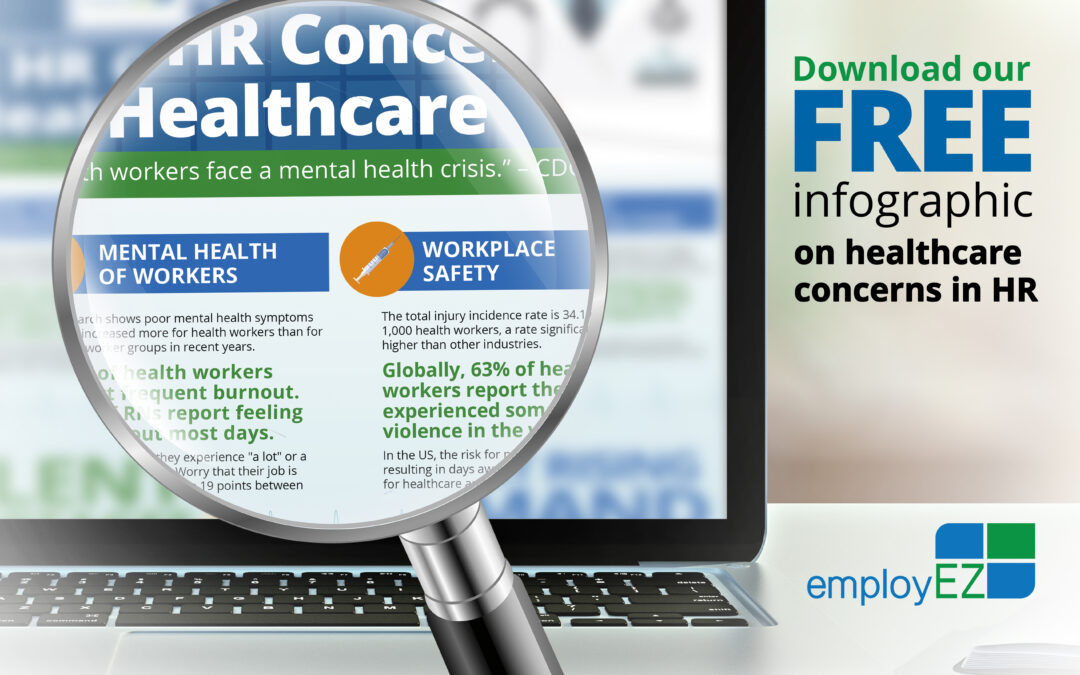
by Kaerrie Hall | May 13, 2024 | Human Resources
What’s keeping healthcare leaders up at night? Talent shortages and what the CDC calls “a mental health crisis” are some of the top HR concerns in healthcare. What else tops the list? Download our free infographic for insights into HR issues in healthcare and strategies to overcome them.
Overcoming the Top HR Concerns in Healthcare
Healthcare leaders, from small medical practices to large health systems, are managing stressed and overworked team members. They’re facing staffing and funding shortages. And they’re navigating complex business, regulatory and administrative challenges.
That’s not easy… but here’s what is:
Getting help from the employEZ family of Professional Employer Organizations (PEOs).
employEZ offers a full suite of HR outsourcing services to help your healthcare company:
Let’s discuss how we can help you overcome your top HR concerns. Reach out here to learn more.


by Kaerrie Hall | Apr 18, 2024 | Benefits of a PEO, Human Resources
There’s nothing more exciting than venturing out on your own, creating a business, and watching it grow. Soon, you’re attracting more customers to what you have to offer, and looking for more talent to help you deliver it. That’s great. But the bigger your company gets, the more you spend time managing it. That’s not a model for success. Here’s what is: Outsourcing HR-related services like HR administration, payroll processing, workers’ compensation, and employee benefits to a Professional Employer Organization (PEO).
Success with HR Outsourcing
That’s where we come in. The employEZ family of PEOs provides HR solutions and services that fit your business size and needs. Count on us to:
- Manage payroll processing and payroll tax reporting
- Provide claims management
- Stabilize your workers’ compensation costs
- Eliminate time-consuming HR administrative tasks
- Assist you with compliance in labor laws, OSHA, and other regulations
- Provide access to funding sources for your payroll
- Help you attract and retain top talent with comprehensive employee benefit packages, including healthcare insurance, dental, vision, and 401(k)
You’ll benefit from the relationships we’ve made with top companies, our purchasing power and our collective expertise.
Get Our Free Guide to HR Outsourcing
Want to know more about HR outsourcing through a PEO and the types of services they provide? Curious how companies like yours can benefit from having a co-employment relationship with a trusted PEO from the employEZ family of PEOs? Contact us today and request your free copy of our guide to HR outsourcing for small business success here: info.employ-ez.com/hr4smb.

by Kaerrie Hall | Feb 12, 2024 | Benefits of a PEO, Employee Benefits
A healthy workforce is a productive workforce. By offering health insurance to employees, businesses contribute to overall employee well-being, providing employees easier ways to take better care of themselves and their families and fostering early detection and treatment of illnesses. This proactive approach not only reduces absenteeism but also amplifies productivity, forming a symbiotic relationship between company and employee. Beyond the obvious value offering health insurance brings to employees, there are many ways offering health insurance is good for business.
Providing Employee Benefits Helps Companies Attract and Retain Talent
Establishing yourself as an employer that offers comprehensive employee benefits can create a competitive advantage, helping you not only attract great candidates, but avoid losing the talent and experience you already have on your team. With so many job candidates looking for more than a good salary, exploring your options for providing healthcare and ultimately lowering your turnover rates makes good business sense. Offering employee benefits can be easier and more cost-effective than you think when you work with a Professional Employer Organization (PEO). A PEO can leverage its size and purchasing power to negotiate far better rates for health benefits, workers’ compensation and more, and pass those savings on to you.
Good Health Can Boost Employee Productivity, Morale and Engagement
Caring for employees goes beyond a paycheck; it extends to their well-being. Offering health insurance helps alleviate the financial burden of medical expenses for your employees. Additionally, many health plans include support services to address mental health issues as well as programs that are proactive in encouraging preventive care and healthier living. This can help create a more positive work environment that significantly impacts company culture, morale, and overall performance.
Tax Advantages Create a Win-Win Scenario
Often overlooked, the tax advantage of offering health insurance under a cafeteria plan is a win-win scenario. Health insurance premiums, deducted pretax, reduce taxable income for both employees and employers. This strategic leverage helps everyone manage costs more effectively.
Offering Health Insurance Helps Larger Companies Comply with the ACA
For larger companies – generally those with 50 or more full-time equivalent employees – offering health insurance is essential for complying with the Affordable Care Act (ACA). The insurance offered must meet ACA standards and non-compliance can result in penalties. But it’s important to note that you do not have to be a large employer to offer health insurance to your employees. Increasingly, smaller companies are finding tremendous value in providing employee benefits and more opportunities to do so affordably thanks to the help of a PEO.
Ask Us About Employee Benefits
The experts at employEZ believe strongly that smaller companies and their employees deserve the benefits of larger corporations. Let us identify the right PEO and Fortune 500-level benefits for your needs. Our PEOs have already navigated the complexities of evaluating healthcare options and created partnerships that give you plenty of choice and value. Additionally, our HR specialists can help you administer employee benefits so you don’t have to keep up with regulations or handle the ins and outs of providing healthcare. Reach out here to learn more.


by Kaerrie Hall | Dec 15, 2023 | Benefits of a PEO
Every business faces some form of risk. There are internal risks like workplace injuries, employee fraud, equipment malfunctions or unexpected delays in production. There are external risks like environmental issues, regulatory changes and new competition entering the market. Risk can also come from both positive and negative sources. For example, expanding into new markets, adding services or acquiring another company can be positive, but each opportunity can add potential risk.
Preparation is the Best Defense
The good news is, business owners can make risk management a priority without compromising their time and focus on core competencies. To do this, they can turn to the expertise and risk management services of a Professional Employer Organization (PEO). Leveraging a PEO’s knowledge of risk assessment and risk mitigation, they can better identify and avoid risk. They can also effectively foster a workplace culture that champions transparency, trust and safety.
Comprehensive Risk Management Services
By providing access to a wide range of risk and safety management services, a PEO can:
- Provide customized safety and training programs for employees
- Identify gaps in safety measures to better protect the company’s resources
- Design risk management strategies suited to the company’s size and industry
- Implement protocols to make risk management seamless and efficient
- Help companies navigate industry-specific challenges and regulatory landscapes
- Safeguard the business from potential pitfalls, both expected and unexpected
- Keep businesses on the right side of legal and regulatory frameworks
- Reduce the likelihood of costly fines and legal disputes
What Should You Expect from Your PEO?
To get the most value from risk management services, business owners should look for a PEO that supports all of the above plus offers:
- A dedicated professional safety manager
- Development of professional safety manuals and handbooks
- Professional code audits for accuracy and compliance
- One-on-one consulting to improve the company’s risk and safety programs
Guidance in risk management and support from a PEO can be invaluable. Don’t go it alone. To learn more about services from the employEZ family of PEOs, please click here. You can also use the contact form here to reach out with any questions and an employEZ consultant will be happy to respond.






